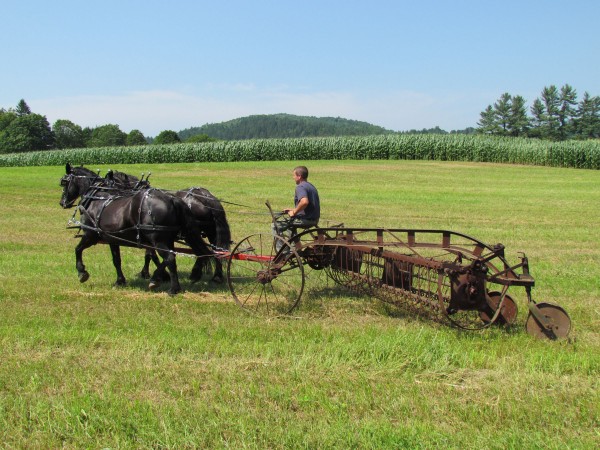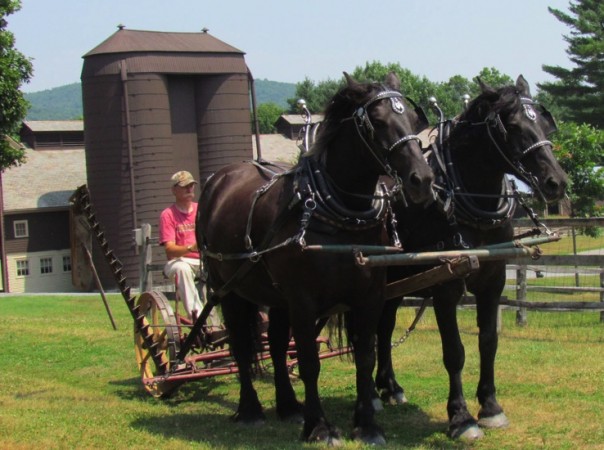Hay Day (And Jerseys) at Billings Farm & Museum

Hay tedder – also known as a “kicker” – this is an 1894 International Harvester. Photo: Billings Farm & Museum.
Or meet sheep, horses, oxen, and chickens and tour an authentically restored 1890 farmhouse and a creamery where butter was produced for market. (Nowadays, Billings Farm milk is shipped to Agri-Mark Co-op, destined for the award-winning cheese produced at the Cabot or Grafton Village sites.)
Owned and operated by The Woodstock Foundation Inc., a non-profit founded by Mary French and Laurance Spelman Rockefeller, the farm not only celebrates rural heritage but also continues a legacy of continuous commercial farming for more than 130 years.
 With a drought in so many parts of the U.S. stunting forage yields, consider the stewardship of fertile (and well manured) land that may withstand prolonged dry spells. Feed for livestock depends on the soils and care with which it is grown, harvested, stored. According to a recent Associated Press report, “quality alfalfa that typically sells for $150 a ton now fetches $240, even if it must be trucked hundreds of miles.”
With a drought in so many parts of the U.S. stunting forage yields, consider the stewardship of fertile (and well manured) land that may withstand prolonged dry spells. Feed for livestock depends on the soils and care with which it is grown, harvested, stored. According to a recent Associated Press report, “quality alfalfa that typically sells for $150 a ton now fetches $240, even if it must be trucked hundreds of miles.”
For the top prices of hay per small square bale, see this Agriculture.com report.
Something to ponder as you peruse the farm museum's collection of tools or observe the daily care and milking of awarding-winning Jersey cows. (Jersey devotees take note: Frederick Billings' interest in Jerseys dates back to his purchase of bulls and cows with direct Isle of Jersey bloodlines. The originator of his herd being the great Jersey cow “Pet Gilford 3317.”)
From the history of the farm: “The Billings Farm was established in 1871 by Frederick Billings, a native Vermonter who became known for his work as a lawyer, conservationist, pioneer in reforestation and scientific farm management, and railroad builder. Billings set out to make his 270-acre farm a model dairy operation. In 1884 he hired George Aitken, an innovative and successful professional farm manager. . . Deeply concerned with the desperate condition of Vermont's forest cover, Billings planted more than 10,000 trees in the Woodstock area, putting into practice ideas that were proposed by an earlier resident of the farm, George Perkins Marsh. Marsh is recognized as one of this country's first conservationists.”“By 1890, the year that Frederick Billings died, the Billings Farm had been expanded to nearly 1,000 acres and was widely acknowledged for its premier Jersey herd, Southdown sheep, and Berkshire hogs . . .”
Note: Draft horses and teamsters will help thin trees at the Marsh-Billings-Rockefeller National Historical Park, which adjoins the farm and is an operating partner with shared public parking and visitor orientation space at the farm's visitor center. Draft horses will be used in addition to mechanized equipment to skid logs out of the woods. More about that here.

Fast forward to 2012; today, the farm is home to one of the premiere Jersey herds in North America.
The “Premier Exhibitor Award” went to Billings Farm at the 2012 New York Spring Dairy Carousel, the second largest dairy show in the nation with more than 900 cattle from 20 states and one Canadian province competing. (More show results, linked here.)
Another notable achievement: The American Jersey Association Living Lifetime Production Award to “Billings Barber Sasha” just 10 days after she (still producing milk daily) turned 15. “Sasha is the only cow in New England to place in any of the three categories – 10th in the nation for total milk production with 218,809 pounds of milk, moving up five spots from last year. She placed 11th nationally for total fat, with 10,220 pounds; and 15th for total protein, with 7,514 pounds,” according to farm reports.
Details: Consider an overnight stay in the area, there is so much to see and enjoy. Admission is $12; children, 5 to 15, $6; 2 and younger, free. Located a half mile north of the Woodstock village green on Route 12. For information call (802) 457-2355 or visit www.billingsfarm.org.


